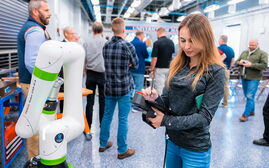
STEM is no longer a stereotype, but Maine's workforce struggles to align with business needs
 Photo / Tim Greenway
Maine is fertile ground for STEM development, says Walter Rawle, chairman of the Maine chapter of the Institute of Electrical and Electronics Engineers.
Photo / Tim Greenway
Maine is fertile ground for STEM development, says Walter Rawle, chairman of the Maine chapter of the Institute of Electrical and Electronics Engineers.
Scientists in lab coats and Silicon Valley coders — that’s what usually comes to mind when thinking about science, technology, engineering and mathematics, or STEM.
But STEM is more than the stereotype. It includes diverse disciplines feeding ever-changing industries, and Maine is fertile ground for STEM development, says Walter Rawle, chairman of the Maine chapter of the Institute of Electrical and Electronics Engineers.
He cites innovations in traditional industries like forestry, agriculture and fishing; and new developments in fields as disparate as bioscience, health care, artificial intelligence, machine learning, autonomous vehicles, military applications and a concept in the works to develop a Maine spaceport complex.
“There’s huge demand for research, development and technical and product development in those areas,” he says. “The pandemic is also fertile ground for innovation, everything from automated artificial intelligence techniques for contact tracing to improvements in diagnostics and physics-based models that describe the aerosolized transport of the virus.”
“We’re seeing all kinds of opportunities for STEM workforce development in Maine,” University of Maine President Joan Ferrini-Mundy says, citing engineering as a particularly high-growth field.
Robust climate
Even with a growing number of opportunities, including jobs in Maine, Ferrini-Mundy says there need to be better connections between educational systems and workforce development. STEM talent development, she says, depends on several primary components:
- Better educational alignment from pre-K through higher education
- Robust R&D
- Public-private partnerships that drive R&D
“The importance of bringing more research and development to Maine is interwoven in having a talented workforce that can drive that research and development forward,” she says.

The climate for advancing STEM in Maine is robust.
She cites heritage industries as “extraordinary” STEM opportunities that evolve with new technologies. The forest products industry, she says, is today more than lumber, paper and pulp. New initiatives are underway with the University of Maine to develop bio-based composite materials in conjunction with new 3D-printing capabilities that are poised to quickly produce large manufacturing components.
But finding talented people with the right STEM skills is not always easy, says Johanna Szillery, a senior project scientist at Bangor-based Haley Ward Inc. (formerly known as CES Inc.).
“Whether we’re looking for surveyors, engineers or folks in the environmental field, it seems we spend a fair amount of effort finding the right people,” she says.
Why the disconnect?
Even with a foundation in STEM education, job candidates often need to demonstrate to potential employers a specific set of skills.
“I think in some ways it’s the nature of what students are not taking,” Szillery says. “In the natural resources realms, what students take in higher education doesn’t match with the skills we’re looking for.”

On her own STEM journey, there was a disconnect between education and career.
“I think there’s a little bit of — you go into a major and you enjoy it, but you’re not quite sure, on the other end, what you’ll be doing with that full-time,” she says. “For me, exposure to mentors and internships was huge, because at least it gave me context for what I could be doing on the other side of college life.”
STEM careers and investment in STEM education are considered critical to Maine’s economic growth. As an economic driver, every direct STEM job supports an indirect job, said Rachel Kerestes, executive director of Science is US, a nonprofit that convenes STEM leaders.
Kerestes spoke during a webinar series recently hosted by the nonprofit and Maine State Chamber of Commerce’s education foundation.
Nationally as in Maine, Kerestes said, STEM supports one-third of direct jobs. Each direct job supports an indirect job.
“There’s no other sector that supports the economy as much as STEM does,” she said in the webinar.
STEM crosses disparate types of work. At Bath Iron Works, every job has a science component that people don’t always recognize, said Ally Coombs, BIW’s director of human resources, who spoke during the webinar series.
Many are obviously STEM related, including jobs in material and environmental sciences, health and safety, ship design, engineering and the digital technology that go into design and engineering, for starters.
Some might be surprised to realize that the trades — such as welders, electricians and blasters — and even administrative functions are also grounded in STEM disciplines, Coombs said.
The biggest challenge is finding STEM-skilled workers, especially in the trades. STEM candidates are in high demand. But the scholastic environment, Coombs said, lacks sufficient capacity and resources to produce enough candidates and to familiarize students with connections between their personal interests and corresponding career opportunities.
In its own efforts to foster STEM development, BIW participates in educational programs and offers apprenticeship and professional development programs.
“We’ve got to educate kids from the very beginning, all the way down to kindergarten, getting them to understand these career paths are lucrative, there’s a lot of them and they’re a great opportunity,” Coombs said in the webinar.
Haley Ward also fosters education-to-career connections through partnerships with higher ed.
“What I find is you have to form relationships with the advisor or the professor to get that discussion going and keep it rolling,” Haley Ward’s Szillery told Mainebiz.
Maine lags
Data show that Maine lags the nation in developing a workforce for science and engineering jobs.
But there’s no reason Maine can’t catch up in the STEM fields in general, said Heather Johnson, commissioner of the Maine Department of Economic and Community Development, who spoke during the webinar series.
Johnson said Maine must better align its educational systems — including pre-kindergarten through grade 12, higher education institutions, retraining opportunities, and community and technical schools — to create “a continuum of workforce” that meets the business community’s needs in the STEM economy.
Johnson recounted a meeting between her agency and a couple of life science businesses thinking about locating in Maine. They weren’t worried about finding Ph.D. scientists so much as lab technicians, she said.

Johnson noted that Maine’s new 10-year strategic economic development plan, released by Gov. Janet Mills last December, called for building on Maine’s “heritage” industries of farming, forestry and fishing to drive innovation and a diverse economy for the future. And she cited the Harold Alfond Foundation’s recent $500 million pledge in charitable grants to Maine schools and organizations to support the goals of the plan.
The gifts are a major resource that helps Maine stand out as the state works on developing STEM talent, she said.
Filling STEM jobs, which are expected to grow in number in the future, means developing the skills in resident Mainers, keeping them in Maine, and attracting out-of-state students and adults, Johnson said.
The Department of Economic and Community Development is looking at tools to align opportunities so business and learners can find each other; to help students, even from an early age, to understand what a STEM career looks like and how to get there; and to help displaced workers get jobs available now and in the future.
The average salary for a life science job, Johnson noted, is $87,000, compared with $38,000 for a non-STEM.
The nature of STEM careers is a moving target: jobs of the future might not even exist today. So what should today’s STEM education look like?
Says Ferrini-Mundy, “I’d say the ability to work across different disciplines, and collaborate across fields and backgrounds, needs to be built into university preparation for STEM fields. The future of Maine will hold robust partnerships. I think it can be a bright future, but we have to stay focused on what it can be and not only on how to strengthen what we currently have in place.”













0 Comments